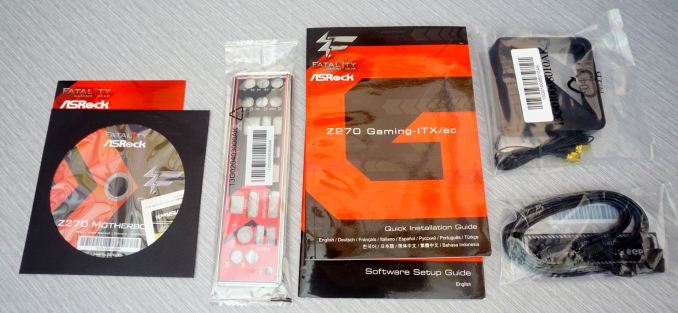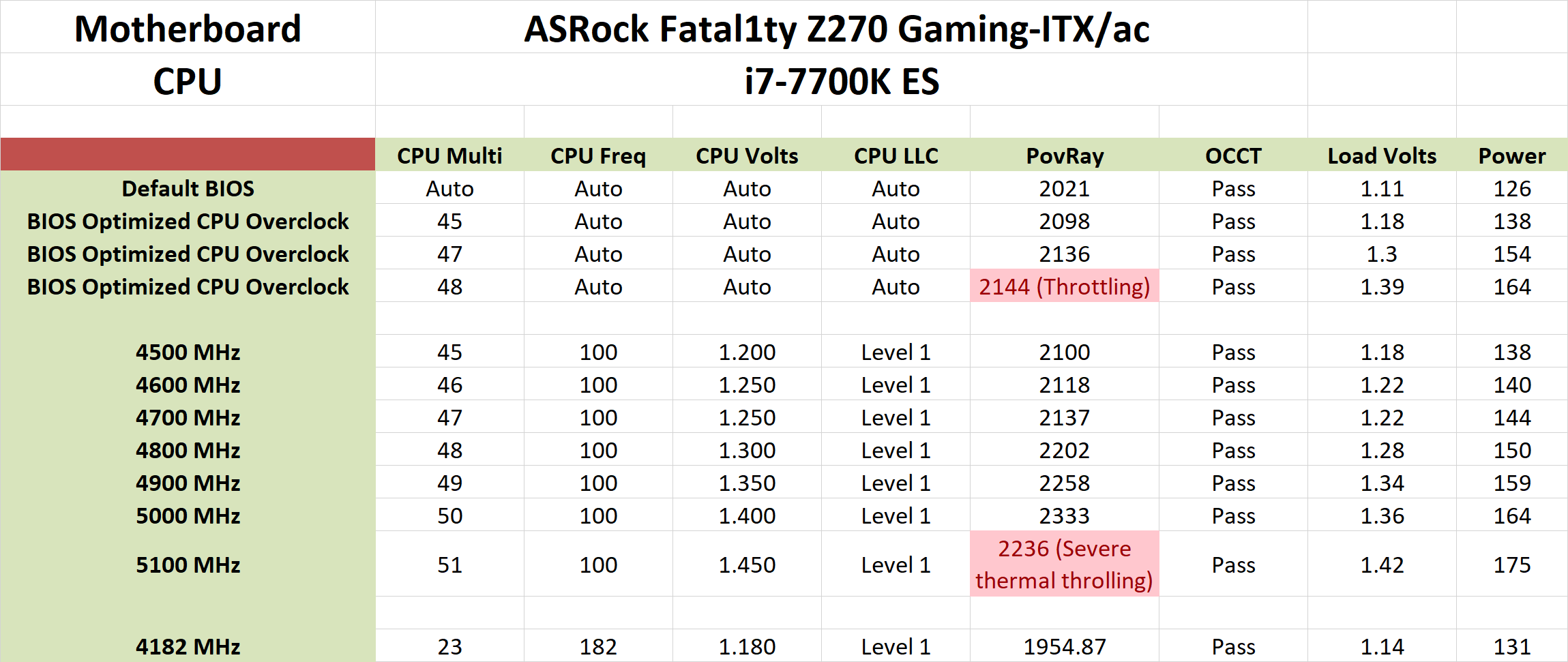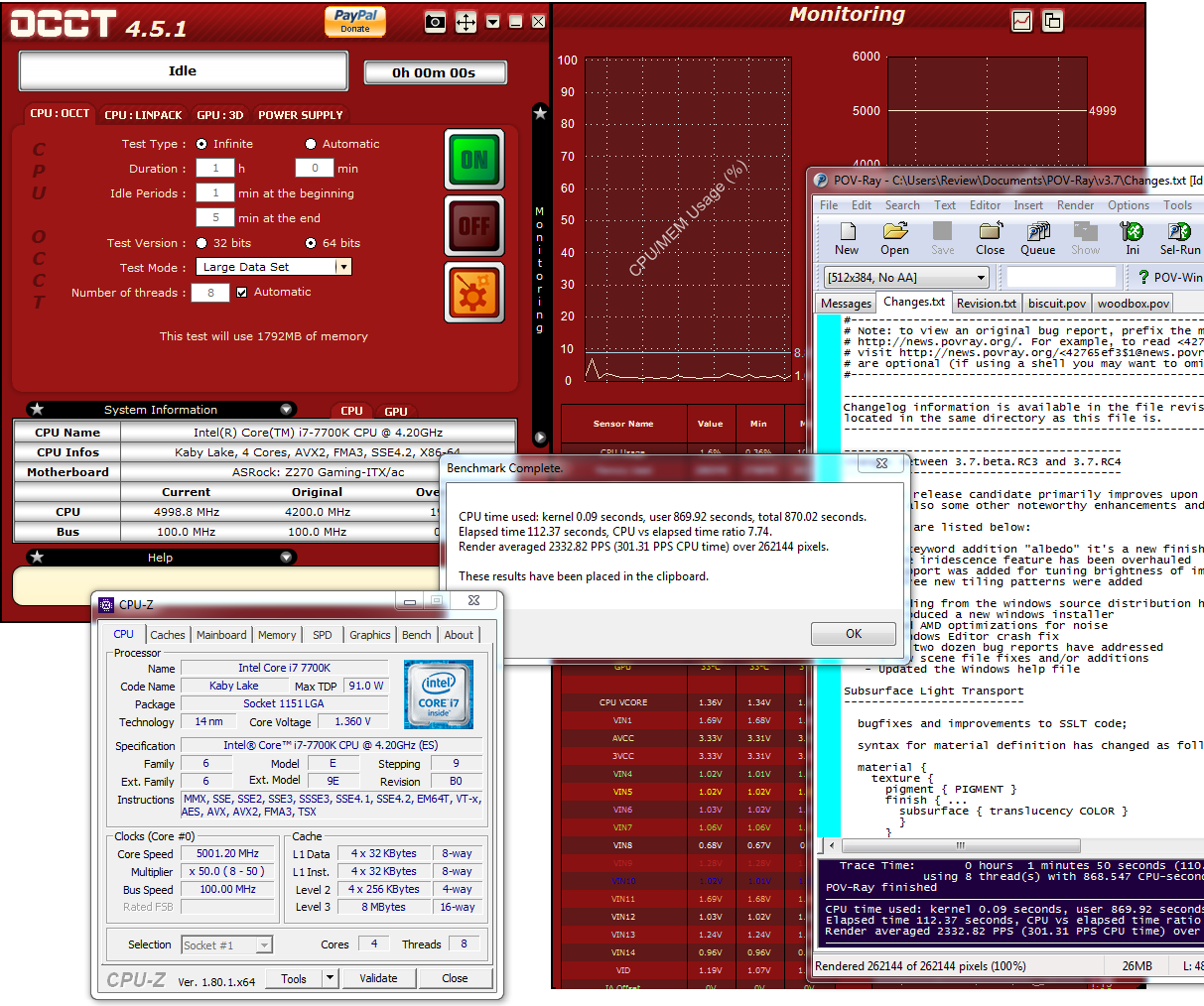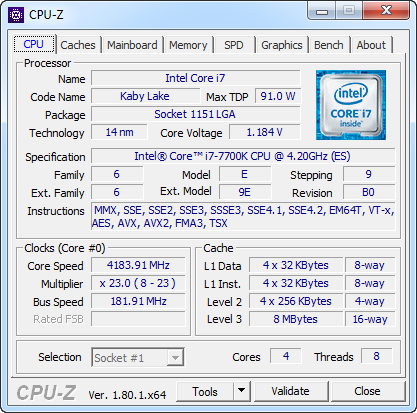The ASRock Fatal1ty Z270 Gaming-ITX/ac Motherboard Review
by E. Fylladitakis on September 19, 2017 9:00 AM EST- Posted in
- Motherboards
- Intel
- ASRock
- Mini ITX
- Z270
- 7700K
- Z270 Gaming ITX/ac
The ASRock Z270 Gaming-ITX/ac Review
Board Features
ASRock’s design approach with the Z270 Gaming-ITX/ac is an attempt to fit as many features on a Mini ITX motherboard as possible while sustaining a relatively reasonable retail price tag, trying to entice virtually all of the advanced PC users; overclockers, advanced gamers and HTPC enthusiasts. A quick look reveals the presence of high-end controllers and advanced power circuitry. The company even installed features that we would have never expected to see on a Mini ITX motherboard, such as a SATA Express connector. Despite all that, the price tag is not as salty as we originally anticipated, with the Z270 Gaming-ITX/ac currently retailing for $159, a reasonable price for an advanced gaming motherboard.
| ASRock Fatal1ty Z270 Gaming ITX/ac | |
| Warranty Period | 3 Years |
| Product Page | Link |
| Price | Link |
| Size | Mini ITX |
| CPU Interface | LGA1151 |
| Chipset | Intel Z270 |
| Memory Slots (DDR4) | Two DDR4 Supporting 32GB Dual Channel Up to 3866 MHz |
| Memory Slots (DDR3L) | None |
| Video Outputs | HDMI 2.0 DisplayPort 1.2 |
| Network Connectivity | Intel I219-V Intel 802.11ac AC7265 |
| Onboard Audio | Realtek ALC1220 |
| PCIe Slots for Graphics (from CPU) | 1 x PCIe 3.0 (x16) |
| PCIe Slots for Other (from PCH) | None |
| Onboard SATA | Six, RAID 0/1/5/10 |
| Onboard SATA Express | One |
| Onboard M.2 | 1 x PCIe 3.0 (x4) |
| Onboard U.2 | None |
| USB 3.1 | One Type-C (Intel JHL6240) |
| USB 3.0 | 6 x Type-A Rear Panel 2 × via headers |
| USB 2.0 | 2 × via headers |
| Power Connectors | 1 x 24-pin ATX 1 x 8-pin CPU |
| Fan Headers | 1 x CPU (4-pin) 1 x Pump/Aux (4-pin) 1 x System (4-pin) |
| IO Panel | 6 x USB 3.0 (USB 3.1 Gen 1) 1 x USB 3.1 Type-C/Thunderbolt 3 1 x CMOS Reset Button 1 x Network RJ-45 1 x DisplayPort 1.2 1 x HDMI 2.0 1 x Combo PS/2 6 x 3.5 mm Audio Jacks 1 x Optical SPDIF Out Port |
In The Box
We get the following:
- Driver Disk
- Quick Installation Guide
- Software Setup Guide
- Rear I/O Shield
- Two black SATA cables (one straight, one with a 90° connector)
- Wireless antenna
ASRock decided that the correct place to be frugal is the bundle, omitting any extra accessories that would increase the price tag of the motherboard. Inside the box we only found the typical user’s manual/software guide, a drivers/applications DVD, a metallic I/O shield, and two SATA cables. There is also a single square antenna that works for both the WiFi and Bluetooth. Its WiFi range does not seem to be significantly different than that of a typical antenna but the Bluetooth reception was astoundingly powerful, at least in comparison to that of cheap USB to Bluetooth adapters. During our testing, the Z270 Gaming-ITX/ac seamlessly pushed an audio stream to a Bluetooth speaker nearly 8 meters away and through a 12 cm wooden wall.
Overclocking with the ASRock Z270 Gaming-ITX/ac
ASRock is placing a lot of marketing effort on the promotion of the Z270 Gaming-ITX/ac as an “overclocker’s” motherboard. On paper, ASRock did install a relatively advanced power circuit and high-quality components with a very significant overhead that are equal to or better than what we usually find on most motherboards around this price range, regardless of their size.
A dive into the motherboard’s BIOS reveals a very good selection of frequency and voltage control options, yet most have a very narrow range. For example, the CPU voltage can “only” be set up to 1.5 volts. That will be more than enough for the average home gamer and casual overclocker but may be limiting for experts with exotic cooling solutions.
Methodology
Our standard overclocking methodology is as follows. We select the automatic overclock options and test for stability with PovRay and OCCT to simulate high-end workloads. These stability tests aim to catch any immediate causes for memory or CPU errors.
For manual overclocks, based on the information gathered from previous testing, starts off at a nominal voltage and CPU multiplier, and the multiplier is increased until the stability tests are failed. The CPU voltage is increased gradually until the stability tests are passed, and the process repeated until the motherboard reduces the multiplier automatically (due to safety protocol) or the CPU temperature reaches a stupidly high level (100ºC+). Our test bed is not in a case, which should push overclocks higher with fresher (cooler) air.
Overclock Results
Although we were hesitant at first, the Z270 Gaming-ITX/ac proved to be a very stable overclocking motherboard, pushing our Intel 7700K ES all the way up to 5.0 GHz. What kept us from going further is the thermal performance of our CPU, which is a lousy thermal performer due to its poorly seated lid. Despite the very high CPU temperature and its relatively high-power demand at 5 GHz, the Z270 Gaming-ITX/ac successfully completed prolonged stability tests.
The automatic CPU overclocking options, or the “optimized CPU overclock settings” as ASRock likes to call them, do work but they are hardly optimized. As ASRock had to play it safe and maximize the stability of a potentially poor overclocker CPU, the CPU voltage that each of the automated options sets is quite high. This can result to much higher energy consumption and temperatures with chips that are mediocre to good overclockers and do not require as high a voltage. Our own 7700K failed the test at 4.8 GHz due to the exceedingly high temperatures, whereas manual control allowed us to perform fully stable overclocks at 4.8 GHz and beyond. Ultimately, what limited us was the thermal performance of our CPU and not the motherboard.
The Z270 Gaming-ITX/ac also handles high BCLK frequencies well, with the maximum fully stable frequency that we managed to reach being 182 MHz. Note that the newer motherboard designs decouple the CPU bus from the rest of the frequency domains in order to allow for these high BCLK overclocks, meaning that the performance of other components and the system’s overall bandwidth remains unaffected. On the contrary, frequency misalignments can cause an overall performance drop. Thus, this technique is useless to users who have unlocked CPUs and should be used only to overclock locked CPUs.














41 Comments
View All Comments
Gothmoth - Tuesday, September 19, 2017 - link
would love anandtech doing a in-depth VRM analysis like some youtube chanels do....i can read the specs myself on the manufacturer website.
spend some of that time on more useful things.
peterfares - Tuesday, September 19, 2017 - link
Why is there a SATA Express? I guess you can use it to connect U.2 drives right? But only at 2 lanes?DanNeely - Tuesday, September 19, 2017 - link
Probably equal parts design inertia, the sockets are cheaper than 2x sata because obsolete, and to support USB3.1g2 front panel devices. The latter needs 2 lanes of PCIe, so 1x slots aren't a good fit like for adding other forms of IO.BrokenCrayons - Tuesday, September 19, 2017 - link
It was sort of a cheap bandaid solution to the problem of SATA 3.0 bottlenecking contemporary SSDs that has never and probably won't ever take off since we now have M.2 interfaces instead. The idea was to quickly and cheaply double SATA 3.0 speeds in a backwards compatiable manner. Wikipedia has a pretty good article on it here if you want to know more:https://en.wikipedia.org/wiki/SATA_Express
OFelix - Tuesday, September 19, 2017 - link
I have the Z170 and used the feature to submit a support ticket direct from the BIOS.I was pleasantly surprised to receive a quick response from tech support.
On the Z170 I found that one of the fan headers would not allow speed control. Hopefully that has been fixed (review says that all fan headers support PWM).
Question: What devices could I buy today to use with SATA Express? Is it intended as internal or external expansion?
I want to build a system with multiple "personalities" by plugging in different external boot drives would thunderbolt or SATAe be suitable/better for this?
Thanks
Oxford Guy - Monday, September 25, 2017 - link
Good luck getting them to patch the BIOS for that board to fix the hyperthreading crash bug.Intel released the code to board makers in April. Here we are with AsRock sitting on its thumb.
punjabiplaya - Tuesday, September 19, 2017 - link
I've been running this board in my main rig since it launched. i7 7700k and a GTX1080 in a fractal nano. It's great.The_Assimilator - Tuesday, September 19, 2017 - link
Damn, that Thunderbolt chip is literally physically larger than the USB C port it's used for. Intel needs to slim that mofo way down if they want to fit it in the CPUs and/or south bridges, because that's the only way TB is ever gonna gain traction.DanNeely - Wednesday, September 20, 2017 - link
Yup. One of the reasons why really high speed IO is expensive, TB3 wasn't built into chipsets from the start, and why not all chipset USB ports are the fastest possible version is that doing it needs lots of transistors which means a relatively large amount of die size. You can see the same thing with USB3 only cards where the USB controller itself is the same size as the USBC port.ex
https://www.aliexpress.com/store/product/ASM1142-C...
only1jva - Tuesday, September 19, 2017 - link
I've owned this motherboard since March and it has begun to fail on me. After playing games like Civilization 6 and Xcom 2, the PC will completely freeze. After powering it down by holding down the power switch, I am unable to power it back on as the machine will turn on briefly then immediately shut down. It repeats this cycle over and over again. I have to wait half an hour to an hour before it turns back on completely.I'm running an i7-7700k AIO watercooler from Corsair, Asus GTX 1080, Corsair case. Not sure what the problem is with this thing but even if I can get into BIOS, it will freeze while in the BIOS screen. I've also tried all the released firmware versions for this board, they all behave the same.
so yeah, never trusting ASRock again.